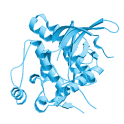
- Remove this product from my favorite's list.
- Add this product to my list of favorites.
Products
Newsletter
 |  |  |  |  |  |

Background: Ack1 is an atypical non-receptor tyrosine kinase. The domain architecture of human Ack1 is formed by a sterile α (SAM) motif at the N-terminus, a kinase catalytic domain, a SH3 domain, a Cdc42/Rac interactive binding (CRIB) domain, a proline-rich region, a clathrin-binding motif and an ubiquitin-binding domain. The position of the SH3 domain C-terminal to the catalytic domain is unique among non-receptor tyrosine kinases and in contrasts with the N-terminal SH3 domain observed in the Src, Csk, Abl. Ack1 is phosphorylated and activated in response to receptor tyrosine kinase stimulation by EGF and activates the guanine exchange factor Dbl. Furthermore, Ack1 is involved in integrin β1-mediated signaling pathways modulating processes such as cell migration, cell adhesion, and cell spreading. In collagen-stimulated cells Ack1 is found in a complex with p130Cas, Crk, and Cdc42 and mediates upon activation by Cdc42 the phosphorylation of p130Cas. Recently it was demonstrated, that Ack1 and Akt (PKB) exists as a complex and activated Ack1 directly phosphorylates Akt (PKB). Ack1 is controlled by autophosphorylation too, but phosphorylation at the major autophosphorylation site Tyr284 causes only a modest increase in enzyme activity. Ack1 gene amplification has been detected in lung, breast and prostate cancers and four nonsynonymous mutations were identified in cancer tissue samples. The cancer-associated mutations enhanced the level of Ack1 autophosphorylation and promoted an increased cell migration.
Recombinant human active ACK1 (Activated CDC42 Kinase 1) / Tyrosine Kinase, non-receptor 2, amino acids G110-W476 (kinase domain), N-terminal GST-HIS6 fusion, protein with a Thrombin cleavage site
Theoretical MW: 71.1 kDa (fusion protein)
Expression system: Sf9 cells
Storage buffer: 50 mM HEPES pH 7.5, 100 mM NaCl, 5 mM DTT, 15 mM reduced glutathione, 20% glycerol
Protein concentration: 0.165 mg/ml (Bradford method using BSA as standard protein)
Method for determination of Km value & specific activity: Filter binding assay MSFC membrane
Specific activity: 72,000 pmol/mg x min
Entrez Gene ID: 10188
UniProtKB: Q07912
Ordering informations: shipped on dry ice
Prieto-Echagüe V, Miller WT. (2011) “Regulation of ack-family nonreceptor tyrosine kinases.” J Signal Transduct. 2011;2011:742372.
Prieto-Echagüe V, Gucwa A, Craddock BP, Brown DA, Miller WT.(2010) “Cancer-associated mutations activate the nonreceptor tyrosine kinase Ack1.” J Biol Chem.;285(14):10605-15.
Mahajan K, Mahajan NP.(2010) “Shepherding AKT and androgen receptor by Ack1 tyrosine kinase.” JCell Physiol;224(2):327-33.
Yokoyama N, Miller WT.(2006) “Purification and enzyme activity of ACK1.” Methods Enzymol.;406:250-60.
Yokoyama N, Miller WT.(2003) “Biochemical properties of the Cdc42-associated tyrosine kinase ACK1. Substrate specificity, authphosphorylation, and interaction with Hck.” J Biol Chem. 28;278(48):47713-23.
Welcome Login
Contact us
Follow us